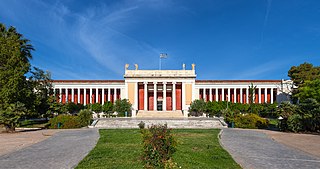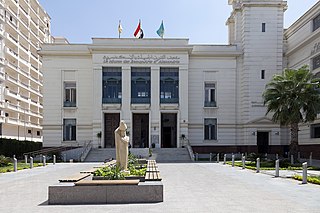
The Graeco-Roman Museum is an archaeological museum located in Alexandria, Egypt.

The Graeco-Roman Museum is an archaeological museum located in Alexandria, Egypt.
Erected in 1892, it was first built in a five-room apartment, inside one small building on Rosetta Street (later Avenue Canope and now Horriya). In 1895, it was transferred to another, larger building near Gamal Abdul Nasser Street. Its first director was Giuseppe Botti. From 1904 to 1932 he was followed by Evaristo Breccia and then Achille Adriani. [1] [2] The museum was inaugurated in 1895 by Khedive Abbas II. [2] The museum edited the Bulletin of the Alexandria Archaeological Society. [2]
The museum contains several pieces dating from the Greco-Roman (Ptolemaic) era in the 3rd century BC, such as a sculpture of Apis in black granite, the sacred bull of the Egyptians, mummies, sarcophagus, tapestries, and other objects offering a view of Greco-Roman civilization in contact with ancient Egypt.
The museum's collection is the product of donations from wealthy Alexandrians as well as of excavations led by successive directors of the institution, both within the town and in its environs. Certain other objects have come from the Organization of Antiquities at Cairo (particularly those of the Pharaonic period) and from various digs undertaken at the beginning of the century in Fayoum and at Benhasa. Housed within a historic building whose beautiful neoclassical facade of six columns and pediment bears the large Greek inscription ‘MOYΣEION’ ("MOUSEION"). The museum consists of 27 halls and an attractive garden, [3] which offer an excellent introduction to Egypt's Greco-Roman period.
The museum was closed for renovations in 2005. [4] In February 2022 the Secretary-General of the Supreme Council of Antiquities, Mostafa Waziri, said that the museum would be opened within a few months. [5] On 11 October 2023, Egyptian Prime Minister Mostafa Madbouly attended the reopening of the museum, following 18 years of renovations. [6]

Alexandria is the second largest city in Egypt and the largest city on the Mediterranean coast. It lies at the western edge of the Nile River delta. Founded in c. 331 BC by Alexander the Great, Alexandria grew rapidly and became a major centre of Hellenic civilization, eventually replacing Memphis, in present-day Greater Cairo, as Egypt's capital. Called the "Bride of the Mediterranean" internationally, Alexandria is a popular tourist destination and an important industrial centre due to its natural gas and oil pipelines from Suez.

The Great Library of Alexandria in Alexandria, Egypt, was one of the largest and most significant libraries of the ancient world. The library was part of a larger research institution called the Mouseion, which was dedicated to the Muses, the nine goddesses of the arts. The idea of a universal library in Alexandria may have been proposed by Demetrius of Phalerum, an exiled Athenian statesman living in Alexandria, to Ptolemy I Soter, who may have established plans for the Library, but the Library itself was probably not built until the reign of his son Ptolemy II Philadelphus. The Library quickly acquired many papyrus scrolls, owing largely to the Ptolemaic kings' aggressive and well-funded policies for procuring texts. It is unknown precisely how many scrolls were housed at any given time, but estimates range from 40,000 to 400,000 at its height.

The Pergamon Museum is a listed building on the Museum Island in the historic centre of Berlin, Germany. It was built from 1910 to 1930 by order of Emperor Wilhelm II and according to plans by Alfred Messel and Ludwig Hoffmann in Stripped Classicism style. As part of the Museum Island complex, the Pergamon Museum was added to the UNESCO World Heritage List in 1999 because of its architecture and testimony to the evolution of museums as architectural and social phenomena.

Roman Egypt was an imperial province of the Roman Empire from 30 BC to AD 641. The province encompassed most of modern-day Egypt except for the Sinai. It was bordered by the provinces of Crete and Cyrenaica to the west and Judaea, later Arabia Petraea, to the East.

The Mouseionof Alexandria, which arguably included the Library of Alexandria, was an institution said to have been founded by Ptolemy I Soter and his son Ptolemy II Philadelphus. Originally, the word mouseion meant any place that was dedicated to the Muses, often related to the study of music or poetry, but later associated with sites of learning such as Plato's Academy and Aristotle's Lyceum.

The National Archaeological Museum in Athens houses some of the most important artifacts from a variety of archaeological locations around Greece from prehistory to late antiquity. It is considered one of the greatest museums in the world and contains the richest collection of Greek Antiquity artifacts worldwide. It is situated in the Exarcheia area in central Athens between Epirus Street, Bouboulinas Street and Tositsas Street while its entrance is on the Patission Street adjacent to the historical building of the Athens Polytechnic university.

Marina, also Marina El Alamein , ancient Leukaspis or Antiphrae, is an upscale resort town catering mainly to the Egyptian upper class. It is located on the northern coast of Egypt, with an 11 km (6.8 mi) long beach, about 300 km (190 mi) away from Cairo, in the El Alamein area.

Alexandria University is a public university in Alexandria, Egypt. It was established in 1938 as a satellite of Fouad University, becoming an independent entity in 1942. It was known as Farouk University until after the Egyptian Revolution of 1952, when its name was changed to the University of Alexandria. Taha Hussein was the founding rector of Alexandria University. It is now the second largest university in Egypt and has many affiliations to various universities for ongoing research.

Serapis or Sarapis is a Graeco-Egyptian god. A syncretic deity derived from the worship of the Egyptian Osiris and Apis, Serapis was extensively popularized in the third century BC on the orders of Greek Pharaoh Ptolemy I Soter, as a means to unify the Greek and Egyptian subjects of the Ptolemaic Kingdom.

Shatby is a neighborhood in Alexandria, Egypt.

The history of Alexandria dates back to the city's founding, by Alexander the Great, in 331 BC. Yet, before that, there were some big port cities just east of Alexandria, at the western edge of what is now Abu Qir Bay. The Canopic (westernmost) branch of the Nile Delta still existed at that time, and was widely used for shipping.

Taposiris Magna is a city established by Pharaoh Ptolemy II Philadelphus between 280 and 270 BC. The name means "great tomb of Osiris", which Plutarch identifies with an Egyptian temple in the city.

The Palais d'Antoniadis is a palace in Alexandria, Egypt, named after Sir John Antoniadis (1818–1895), who was an Alexandrian Greek. He was born in Lemnos and received French citizenship when he began to conduct business in Marseilles. He was also president of the Greek Community in Alexandria and consul general of Belgium. He was knighted by Queen Victoria.
The following is a timeline of the history of the city of Alexandria, Egypt.

Mostafa Abdel-Hamid el-Abbadi was a prominent Egyptian historian, public intellectual and professor specialized in Greco-Roman studies. He died on 13 February 2017, at the age of 88, in Alexandria.

The Alexandria Museum of Fine Arts is a museum for Egyptian and Middle-Eastern fine art situated in the Moharam Bek neighborhood of Alexandria, Egypt. It houses a collection of works by Egyptian artist and a selection of works from Baroque, Romanticism, Rococo and Orientalism. In addition, noteworthy examples of carving, printing and sculpture from Egyptian and European artists. The museum aims to promote art to the local community and to a greater extent Egyptian society, through a selection of activities: art workshops, exhibitions and museum education for children; exhibitions for noted Egyptian artists and international cultural exchange activities.
Khaled al-Anani is an Egyptian egyptologist and politician. He is the current Minister of Tourism and Antiquities.
The history of the Jews in Alexandria dates back to the founding of the city by Alexander the Great in 332 BCE. Jews in Alexandria played a crucial role in the political, economic, cultural and religious life of Hellenistic and Roman Alexandria, with Jews comprising about 35% of the city's population during the Roman Era. Alexandrian Jewry were the founders of Hellenistic Judaism and the first to translate the Torah from Hebrew to Koine Greek, a document known as the Septuagint.
Mervat Seif el-Din, Arabic: ميرفت سيف الدين is a classical archaeologist from Egypt, who was Director of the Graeco-Roman Museum of Alexandria from 2004 to 2010. A specialist in the archaeology of Alexandria, el-Din is an expert on faience and funerary painting in particular.
Annibale Evaristo Breccia was an Italian egyptologist, the second director of the Greco-Roman Museum of Alexandria and rector of the University of Pisa.
https://commons.wikimedia.org/wiki/Category:Greco-Roman_Museum,_Alexandria 31°11′57″N29°54′25″E / 31.199259°N 29.906872°E